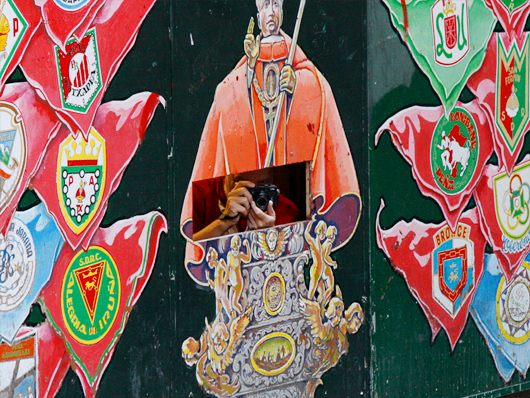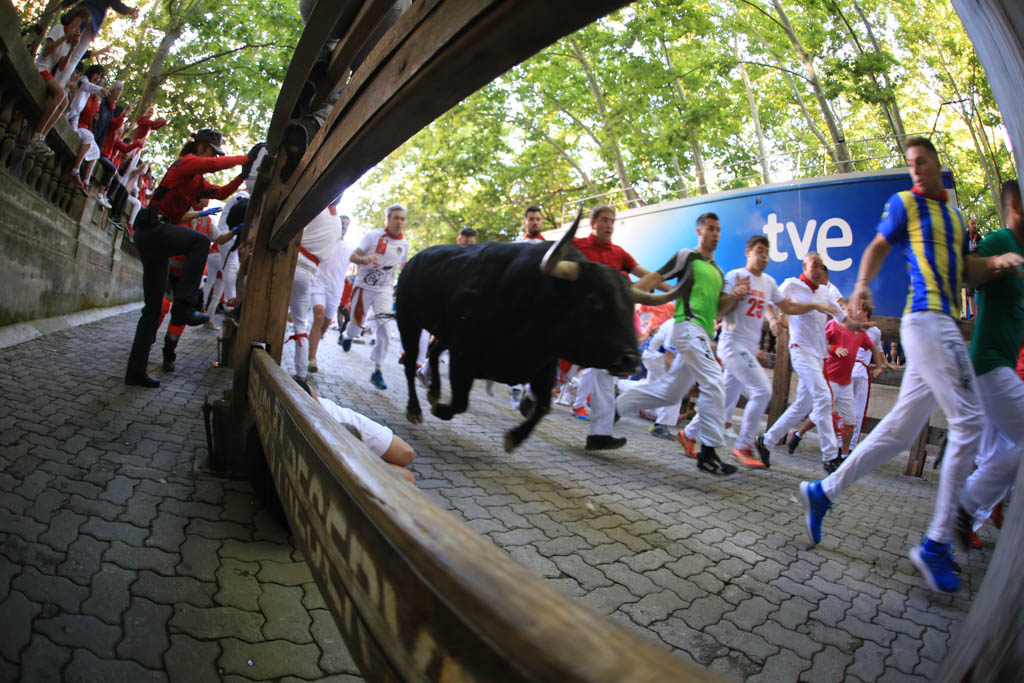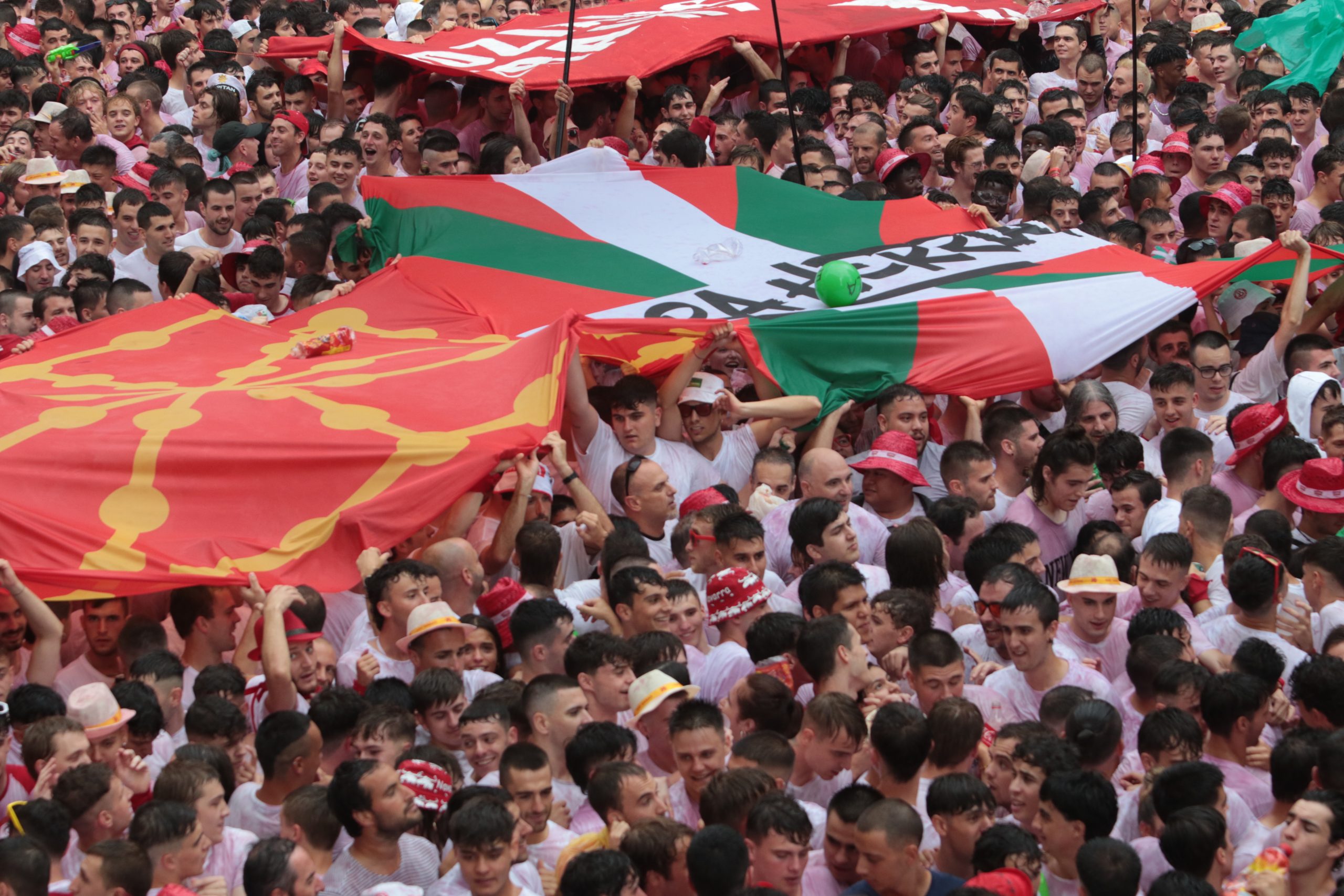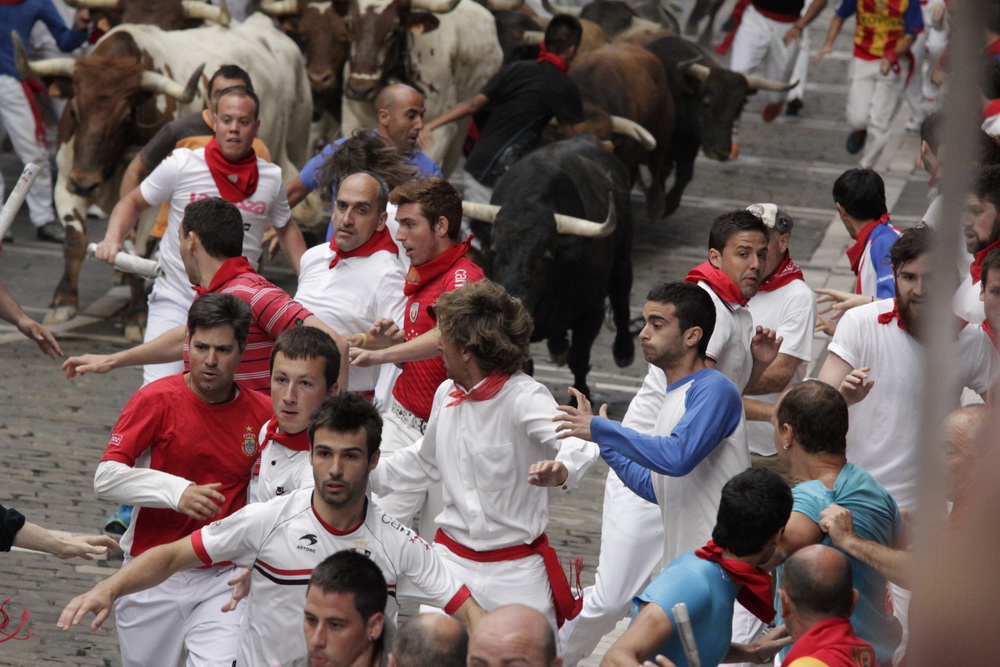We are what we repeatedly do.”
Aristotle
In the first light of a Pamplona morning, before the sun comes up. One of the many habitual runners of the encierro awakes and prepares for his daily test. He does this slowly and deliberately, from ensuring that he is wearing the correct shirt to the way he ties his pañuelo and his shoelaces. Everything has to be just so and this extends to his participation in the prayer to San Fermín, the exact spot where he will wait to run – right down to the very window or door on the street where he always waits. Then, as the first jolting boom of a rocket echoes around the old city and through the hearts of those in the crowd, he kisses a little necklace bearing the image of a saint. He does this always three times and then he feels he is ready.
But only then.
This is a scene that goes far beyond Pamplona and far beyond the encierro. It is repeated in so many other places and on other stages. It is the footballer who stoops to touch the soil of the pitch as he runs on at the start of a match. It is the actor who makes the sign of a cross before he takes to the unforgiving or rousing stage. It is the mother who sings her child to sleep every night after the same bath and the same story which will guarantee her little one will settle quickly.
There is no shortage of ritual in fiestas. From the Alpha of the txupinazo to the Omega of the Pobre de Mi, a succession of stage-managed artefacts is created in the very likeness of those that have gone day before, year before, century before. Rituals are at the heart of a fiesta that, on the face of it appears to be chaotic, anarchic and unstructured. This notion of a free-for-all is only partly true – there is actually order in this chaos. Throughout the day of fiesta there are points of order and structure. Witness the morning prayer to San Fermín with its strict timings, co-ordinated manifestation and impeccably observed structure. It is the ritual that ushers in the cohete to release the bulls, without it the encierro would arguably be lacking an appropriate exclamation point.
Then look no further than the evening corrida, that tragedy played out in three acts and repeated six times. This is crammed full of rituals from the parade of the cuadrillas, the opening of the gate, the acts of the toreros themselves, the songs and music from the crowd, the colours, the costumes, the symbols and the movements. It is a ritualistic play observed every evening in the same way it has for decades and to deviate from it would be met with scorn and derision. The corrida abides by reconnecting the people with their roots and their histories. It creates new stories to layer on top of the years of stories already put down. As Miller Williams says; “Ritual is important to us as human beings. It ties us to our traditions and our histories.”
On a more scientific note, there is plenty to suggest that habits and rituals help our brains to understand that they are on the right track. It gives us a sense of purpose and even allows us to develop. Yet the issue with this is that getting stuck in habits and rituals can stifle our variety and imprison us in a cycle of behaviour that ultimately inhibits us and creates a sense of insecurity once we step away from them. Rituals connect us to our past, but perhaps they also chain us to it. A balance has to be struck, after all many rituals are either beneficial, fun or both so why would we want to dispense with them?
It is easy to argue that many rituals are a pointless routine that not only serve very little purpose but only entrench meaningless superstitions and promote obsessive behaviour. The Christian who makes the sign of a cross will not ward off evil, will not bring about any miracle and will not change anything. It is a gesture, a placebo, a disposable action. It is not a transaction but a “codified norm” as highlighted by Luis Miranda. The codified norm points to a self-programming of activities instead of a genuine connection to the original reason for the ritual. In a quotation that makes neither positive nor negative distinction to the outcome, Charles Reade has said; “Sow an act, and you reap a habit. Sow a habit, and you reap a character. Sow a character and you reap a destiny.”
When ritual becomes nothing more than habit then it follows a law of diminishing returns at best. For a ritual to have true value then it must offer something material, some intrinsic quality, some purpose. This could be by adding additional layers onto our experiences or could merely be the joy of familiarity, the comfort of the known.
Some research indicates that rituals can increase our perception of value and increase a sense of belonging. This is at odds with those who shun the notion of doing things repeatedly, preferring spontaneity. The Christian who makes the sign of the cross could argue that their gesture does indeed have value, connecting them to their faith, reminding them of what they stand for and the importance of their spiritual values.
This connection between ritual and spiritual is widespread. Peter Hollingworth outlined its importance in saying: “I enjoy ritual and ceremony. What I don’t like is when it’s badly done or sloppily done. This is actually a theological issue – the forms we adopt, the actions we take, the way we do things, are, as it were, a sacrament.” While GK Chesterton expressed it in a similar vein; “Ritual will always mean throwing away something: destroying our corn or wine upon the altar of our gods.” For a celebration of the combination of spiritual and ritual, look no further than the fiesta of San Fermín.
Fiesta is a combination of worlds, offering stage-managed set pieces that come around time after time. Yet fiesta also provides an arena for spontaneity to exist and to thrive within certain parameters. Note that the fiesta rituals normally take place within some arena, some boundaries; the Plaza de Toros, the Ayuntamiento, the closed streets of the encierro, the Cathedral. Meanwhile the open street provides a space for spontaneity to develop. The two are able to exist side-by-side.
Yet, the modern world has shown us two things. The first is that we live in unpredictable times where a global pandemic such as Covid-19 can put an abrupt end to our normal way of life. This has included fiestas up and down Spain and beyond, including Pamplona. The impact of Covid has proved that our wonderful rituals are genuinely a delicately held thing; fragile and at the whim of fate. The perceived greater good to society by implementing restrictions has shown that the fiestas are actually expendable and have a lower priority than public safety and the preservation of lives.
The second things we have seen is that we may have felt deep regret over the loss of the fiestas, but we were able to bear the loss through our collective resilience. Partly this is under the banner of a promise of next year; a promise that the fiestas will return and we can throw our weight behind them when they return. What is also clear is that the loss of fiestas, with its financial and morale impacts, is a burden that has not broken us.
What then does this say for the value of our rituals when we consider that they are expendable and we are able to shoulder the burden of their loss? Does this devalue them, or does it merely demonstrate that there is a higher cause when it comes to human life? Some would argue that Covid has proved that many things we hold dear, including fiestas, are merely ephemeral and we should be prepared to rid ourselves of them. Others would argue to the contrary, pointing out that our rituals also act as a datum, a point from which and to which we can always naviage.
In 2020 the rituals vanished and all we could rely on was our memories; the memories of fiestas gone. At least Covid could not destroy our memories. Yet, we are our memories. Without them we stumble on, empty and dry as an arid patch of the Bardenas Reales. Our memories are not merely recollections of events and emotions. Our memories do not simply serve as a library or an indexing service. Our memories are much more than a reference point.
Our memories are our stories, and these stories are intertwined with our lives, our communities and with other lives that we touch and feel. What are we without our stories? Our stories make us who we are. Over time they help to shape us, to guide us and in the end they serve to define us and the paths we take. Rituals are just one of the ways that we tell those stories. Rituals respect the stories and give colour and life to the past, but ultimately allow them to be handed on to a new generation who will keep them, take them to their hearts absorb them into their own sphere and go on to relive them – so retelling the stories in a growing cycle; a pool of ever increasing circles.
Rituals turn our stories into legends and turn the people into heroes. Rituals keep our stories alive.




